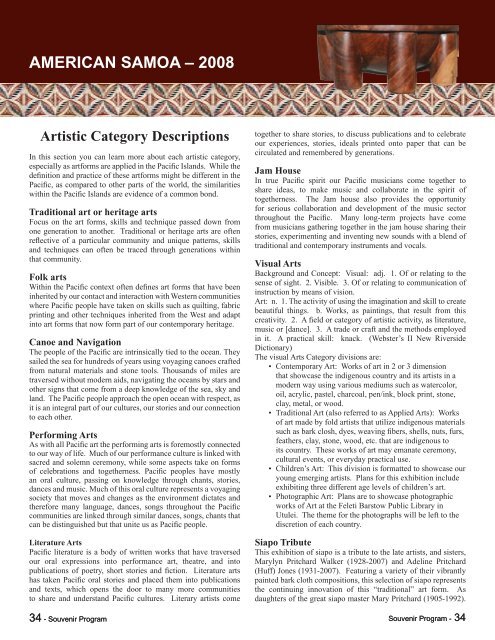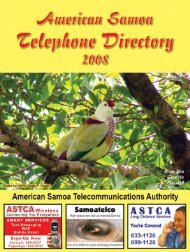10th Festival of Pacific Arts - American Samoa Information
10th Festival of Pacific Arts - American Samoa Information
10th Festival of Pacific Arts - American Samoa Information
Create successful ePaper yourself
Turn your PDF publications into a flip-book with our unique Google optimized e-Paper software.
AMERICAN SAMOA – 2008<br />
Artistic Category Descriptions<br />
In this section you can learn more about each artistic category,<br />
especially as artforms are applied in the <strong>Pacific</strong> Islands. While the<br />
definition and practice <strong>of</strong> these artforms might be different in the<br />
<strong>Pacific</strong>, as compared to other parts <strong>of</strong> the world, the similarities<br />
within the <strong>Pacific</strong> Islands are evidence <strong>of</strong> a common bond.<br />
Traditional art or heritage arts<br />
Focus on the art forms, skills and technique passed down from<br />
one generation to another. Traditional or heritage arts are <strong>of</strong>ten<br />
reflective <strong>of</strong> a particular community and unique patterns, skills<br />
and techniques can <strong>of</strong>ten be traced through generations within<br />
that community.<br />
Folk arts<br />
Within the <strong>Pacific</strong> context <strong>of</strong>ten defines art forms that have been<br />
inherited by our contact and interaction with Western communities<br />
where <strong>Pacific</strong> people have taken on skills such as quilting, fabric<br />
printing and other techniques inherited from the West and adapt<br />
into art forms that now form part <strong>of</strong> our contemporary heritage.<br />
Canoe and Navigation<br />
The people <strong>of</strong> the <strong>Pacific</strong> are intrinsically tied to the ocean. They<br />
sailed the sea for hundreds <strong>of</strong> years using voyaging canoes crafted<br />
from natural materials and stone tools. Thousands <strong>of</strong> miles are<br />
traversed without modern aids, navigating the oceans by stars and<br />
other signs that come from a deep knowledge <strong>of</strong> the sea, sky and<br />
land. The <strong>Pacific</strong> people approach the open ocean with respect, as<br />
it is an integral part <strong>of</strong> our cultures, our stories and our connection<br />
to each other.<br />
Performing <strong>Arts</strong><br />
As with all <strong>Pacific</strong> art the performing arts is foremostly connected<br />
to our way <strong>of</strong> life. Much <strong>of</strong> our performance culture is linked with<br />
sacred and solemn ceremony, while some aspects take on forms<br />
<strong>of</strong> celebrations and togetherness. <strong>Pacific</strong> peoples have mostly<br />
an oral culture, passing on knowledge through chants, stories,<br />
dances and music. Much <strong>of</strong> this oral culture represents a voyaging<br />
society that moves and changes as the environment dictates and<br />
therefore many language, dances, songs throughout the <strong>Pacific</strong><br />
communities are linked through similar dances, songs, chants that<br />
can be distinguished but that unite us as <strong>Pacific</strong> people.<br />
Literature <strong>Arts</strong><br />
<strong>Pacific</strong> literature is a body <strong>of</strong> written works that have traversed<br />
our oral expressions into performance art, theatre, and into<br />
publications <strong>of</strong> poetry, short stories and fiction. Literature arts<br />
has taken <strong>Pacific</strong> oral stories and placed them into publications<br />
and texts, which opens the door to many more communities<br />
to share and understand <strong>Pacific</strong> cultures. Literary artists come<br />
together to share stories, to discuss publications and to celebrate<br />
our experiences, stories, ideals printed onto paper that can be<br />
circulated and remembered by generations.<br />
Jam House<br />
In true <strong>Pacific</strong> spirit our <strong>Pacific</strong> musicians come together to<br />
share ideas, to make music and collaborate in the spirit <strong>of</strong><br />
togetherness. The Jam house also provides the opportunity<br />
for serious collaboration and development <strong>of</strong> the music sector<br />
throughout the <strong>Pacific</strong>. Many long-term projects have come<br />
from musicians gathering together in the jam house sharing their<br />
stories, experimenting and inventing new sounds with a blend <strong>of</strong><br />
traditional and contemporary instruments and vocals.<br />
Visual <strong>Arts</strong><br />
Background and Concept: Visual: adj. 1. Of or relating to the<br />
sense <strong>of</strong> sight. 2. Visible. 3. Of or relating to communication <strong>of</strong><br />
instruction by means <strong>of</strong> vision.<br />
Art: n. 1. The activity <strong>of</strong> using the imagination and skill to create<br />
beautiful things. b. Works, as paintings, that result from this<br />
creativity. 2. A field or category <strong>of</strong> artistic activity, as literature,<br />
music or [dance]. 3. A trade or craft and the methods employed<br />
in it. A practical skill: knack. (Webster’s II New Riverside<br />
Dictionary)<br />
The visual <strong>Arts</strong> Category divisions are:<br />
Contemporary Art: Works <strong>of</strong> art in 2 or 3 dimension<br />
34 - Souvenir Program Souvenir Program - 34<br />
•<br />
•<br />
•<br />
•<br />
that showcase the indigenous country and its artists in a<br />
modern way using various mediums such as watercolor,<br />
oil, acrylic, pastel, charcoal, pen/ink, block print, stone,<br />
clay, metal, or wood.<br />
Traditional Art (also referred to as Applied <strong>Arts</strong>): Works<br />
<strong>of</strong> art made by fold artists that utilize indigenous materials<br />
such as bark closh, dyes, weaving fibers, shells, nuts, furs,<br />
feathers, clay, stone, wood, etc. that are indigenous to<br />
its country. These works <strong>of</strong> art may emanate ceremony,<br />
cultural events, or everyday practical use.<br />
Children’s Art: This division is formatted to showcase our<br />
young emerging artists. Plans for this exhibition include<br />
exhibiting three different age levels <strong>of</strong> children’s art.<br />
Photographic Art: Plans are to showcase photographic<br />
works <strong>of</strong> Art at the Feleti Barstow Public Library in<br />
Utulei. The theme for the photographs will be left to the<br />
discretion <strong>of</strong> each country.<br />
Siapo Tribute<br />
This exhibition <strong>of</strong> siapo is a tribute to the late artists, and sisters,<br />
Marylyn Pritchard Walker (1928-2007) and Adeline Pritchard<br />
(Huff) Jones (1931-2007). Featuring a variety <strong>of</strong> their vibrantly<br />
painted bark cloth compositions, this selection <strong>of</strong> siapo represents<br />
the continuing innovation <strong>of</strong> this “traditional” art form. As<br />
daughters <strong>of</strong> the great siapo master Mary Pritchard (1905-1992).



